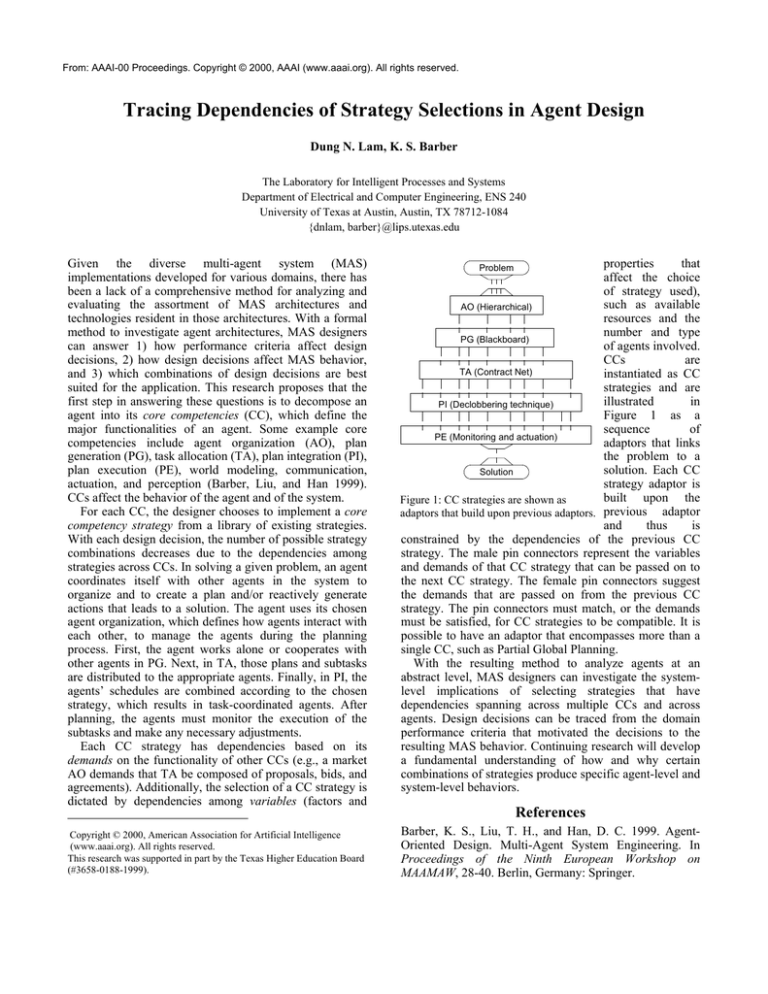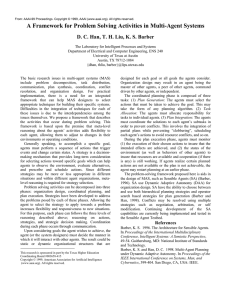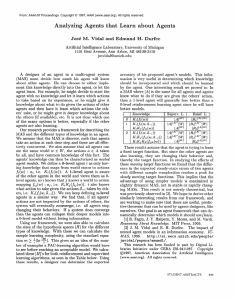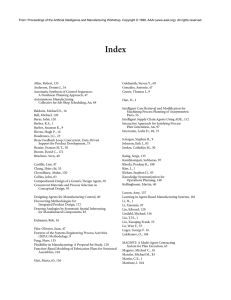
From: AAAI-00 Proceedings. Copyright © 2000, AAAI (www.aaai.org). All rights reserved.
Tracing Dependencies of Strategy Selections in Agent Design
Dung N. Lam, K. S. Barber
The Laboratory for Intelligent Processes and Systems
Department of Electrical and Computer Engineering, ENS 240
University of Texas at Austin, Austin, TX 78712-1084
{dnlam, barber}@lips.utexas.edu
Given the diverse multi-agent system (MAS)
implementations developed for various domains, there has
been a lack of a comprehensive method for analyzing and
evaluating the assortment of MAS architectures and
technologies resident in those architectures. With a formal
method to investigate agent architectures, MAS designers
can answer 1) how performance criteria affect design
decisions, 2) how design decisions affect MAS behavior,
and 3) which combinations of design decisions are best
suited for the application. This research proposes that the
first step in answering these questions is to decompose an
agent into its core competencies (CC), which define the
major functionalities of an agent. Some example core
competencies include agent organization (AO), plan
generation (PG), task allocation (TA), plan integration (PI),
plan execution (PE), world modeling, communication,
actuation, and perception (Barber, Liu, and Han 1999).
CCs affect the behavior of the agent and of the system.=
For each CC, the designer chooses to implement a core
competency strategy from a library of existing strategies.
With each design decision, the number of possible strategy
combinations decreases due to the dependencies among
strategies across CCs. In solving a given problem, an agent
coordinates itself with other agents in the system to
organize and to create a plan and/or reactively generate
actions that leads to a solution. The agent uses its chosen
agent organization, which defines how agents interact with
each other, to manage the agents during the planning
process. First, the agent works alone or cooperates with
other agents in PG. Next, in TA, those plans and subtasks
are distributed to the appropriate agents. Finally, in PI, the
agents’ schedules are combined according to the chosen
strategy, which results in task-coordinated agents. After
planning, the agents must monitor the execution of the
subtasks and make any necessary adjustments.
Each CC strategy has dependencies based on its
demands on the functionality of other CCs (e.g., a market
AO demands that TA be composed of proposals, bids, and
agreements). Additionally, the selection of a CC strategy is
dictated by dependencies among variables (factors and
properties
that
affect the choice
of strategy used),
such as available
AO (Hierarchical)
resources and the
number and type
PG (Blackboard)
of agents involved.
CCs
are
TA (Contract Net)
instantiated as CC
strategies and are
illustrated
in
PI (Declobbering technique)
Figure 1 as a
sequence
of
PE (Monitoring and actuation)
adaptors that links
the problem to a
solution. Each CC
Solution
strategy adaptor is
built upon the
Figure 1: CC strategies are shown as
adaptors that build upon previous adaptors. previous adaptor
and
thus
is
constrained by the dependencies of the previous CC
strategy. The male pin connectors represent the variables
and demands of that CC strategy that can be passed on to
the next CC strategy. The female pin connectors suggest
the demands that are passed on from the previous CC
strategy. The pin connectors must match, or the demands
must be satisfied, for CC strategies to be compatible. It is
possible to have an adaptor that encompasses more than a
single CC, such as Partial Global Planning.
With the resulting method to analyze agents at an
abstract level, MAS designers can investigate the systemlevel implications of selecting strategies that have
dependencies spanning across multiple CCs and across
agents. Design decisions can be traced from the domain
performance criteria that motivated the decisions to the
resulting MAS behavior. Continuing research will develop
a fundamental understanding of how and why certain
combinations of strategies produce specific agent-level and
system-level behaviors.
=
Barber, K. S., Liu, T. H., and Han, D. C. 1999. AgentOriented Design. Multi-Agent System Engineering. In
Proceedings of the Ninth European Workshop on
MAAMAW, 28-40. Berlin, Germany: Springer.
Copyright © 2000, American Association for Artificial Intelligence
(www.aaai.org). All rights reserved.
This research was supported in part by the Texas Higher Education Board
(#3658-0188-1999).
Problem
References





